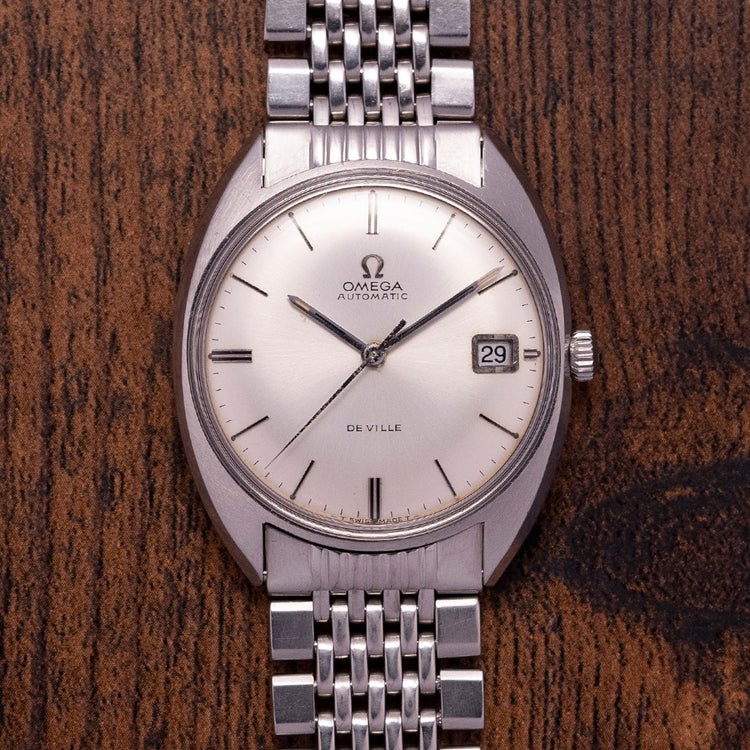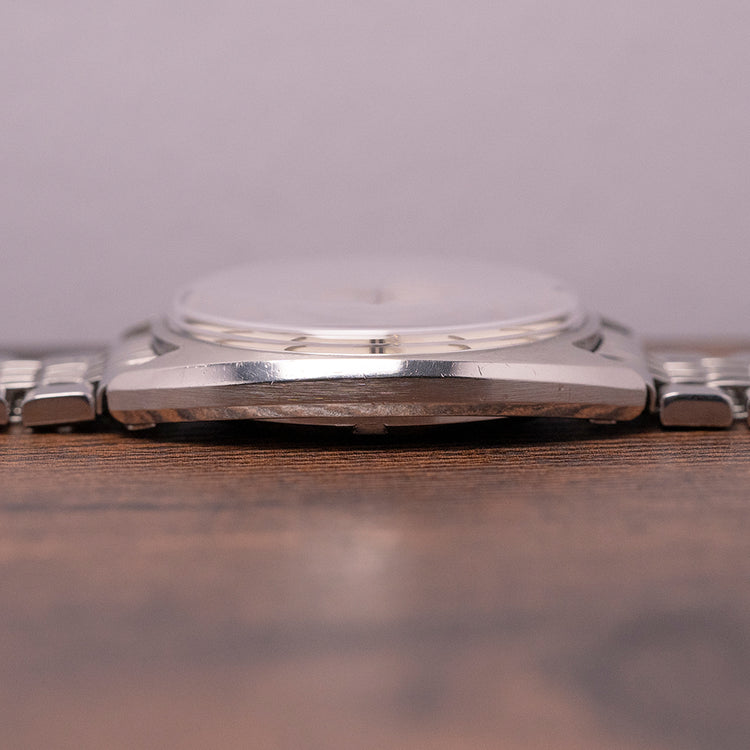More Information
Description
More
Less
The Watch
Here we have a 1968 Omega De Ville Automatic 166.029 with a 34.5mm C-shaped stainless steel case curving over your wrist with tapered lugs, in 1967 Omega launched the De Ville as a stand-alone line, a much more streamlined, varied, and younger feel than the Seamaster, it soon became Omega’s best-selling collection. Polished and brushed surfaces transition with crisp lines along chamfered edges leading to a lug-to-lug length of 39.5mm and a case thickness of 10.5mm ensuring a comfortable fit on your wrist. On the right side is a signed crown. The domed crystal sits above a striking sunburst silver dial, an outer minute track has applied single, and double baton indexes and Tritium pips marking the hours. At 3 o’clock a framed date window and elegant baton hands have Tritium tips complemented by a tapered sweeping second hand completing this stunning vintage dress watch. At 12 o’clock we have the Omega motif and “Omega Automatic'' printed underneath and at 6 o’clock “De Ville''. On the reverse a screw-down case back, inside an automatic Omega Cal. 565, 24 jewels, beating at 19,800 beats per hour, the quickset date is done by repeatedly pulling the crown. The watch comes fitted with its original Omega 19mm “Beads of Rice'' stainless steel Omega-signed bracelet with a signed folding clasp and the watch comes with its original vintage red Omega box, outer box, and original paperwork.
Points of Mention
This watch is sold with an original vintage red Omega box, outer box, and original paperwork. The watch comes paired with its original Omega 19mm “Beads of Rice” stainless steel Omega signed bracelet with a signed folding clasp, this bracelet will fit up to a 7.5inch wrist. The watch is from December 1968 and is in worn vintage condition but overall very fair condition as you can see from the photographs. The watch comes with our 12-Months NON-Waterproof Warranty.
For more photos see here - https://drive.google.com/drive/folders/1BLu2_g0VG3rRUYpvSF1x9k_Xjs9PQVZ0?usp=share_link
4K YouTube video, skip to 17:28 - https://youtu.be/PSYNUupBTnQ
Personal Note
I love it when I can bring a vintage Omega to the website that is in wonderful condition and also comes with its original box and paperwork for under £1,000! As this hobby continues to grow and more and more people become interested in vintage watches these kinds of deals will become harder to find, especially in this condition as these are what people ideally want! So if this interests you, snap it up whilst you can.
Specification
Lugs : 19mm
Condition : Pre-Owned
Box & Papers : Box & Papers
Case Material : Stainless Steel
Warranty : 12-Months Non-Waterproof Warranty
The Brand
Formerly known as the La Generale Watch Co. in 1848 founded by Louis Brandt in La Chaux-de-Fonds. When he died in 1879, his sons carried on his dream. In 1880 they moved to 96 Rue Jakob-Stampfli where they remain today. The brothers produced their first mass-produced calibre, the Labrador In 1885. Just a few years later in 1892, they produced the first minute-repeater. In 1903 they renamed the company Omega until 1982 when they officially changed their name to Omega SA. During WW1 Omega watches were used as official timekeepers for the Royal Flying Corps and the US Army. In 1930, Omega and Tissot merged together to form Société Suisse pour l'Industrie Horlogère (SSIH) In 1931, another group was formed - Allgemeine Schweizerische Uhrenindustrie AG (ASUAG). Where SSIH was primarily French-speaking, ASUAG was founded by the more German-speaking members of the Swiss watch industry. In 1948 they introduced the first edition of one of its most symbolic watches: the Seamaster. Omega first introduced the Constellation in 1952. At the time it was Omega's flagship timepiece. The first models had a Cal. 354 bumper movement in them. Later in 1955, Omega introduced the Automatic Cal. 50x, followed in 1959 by the Cal.55x (no date) and 56x (date) versions. Many of the Constellations came with pie-pan dials, diamond indexes, and fancy lug configurations. All the gold Constellations of that time have the Observatory of Geneva's hand engraved on the back. The stainless steel and stainless steel/gold versions had a gold medallion on the back with the Observatory of Geneva. The eight stars above the Observatory stand for the many exploits of Omega in the world Chronometer competition. Celebrating the fact that all Constellations are Chronometer Certified. In 1962, when astronaut Wally Schirra wore a Speedmaster on his Mercury Sigma 7 Mission, making it the first Omega watch to enter space. After rigorous tests, NASA used Omega for all their Apollo missions including the 1969 Moon landing of Apollo 11. Today Omega is still an astronaut's first choice. In 1969, President Nixon famously said it was “too valuable” and turned down the first-ever all-gold Speedmaster Professional Deluxe. As a response to the ever-growing threat of electronic watches to the manufacturers of mechanical watches, Omega and many Swiss brands such as Rolex and Patek Philippe formed Centre Electronique Horloger (CEH). Prototypes began to appear in 1967 with their production starting in 1968. Then In 1972, Omega introduced the reference, 198.030, which included the Omega calibre 1250, a ‘tuning-fork electronic movement which was made under licence from Bulova. Later we saw a merger of SSIH and ASUAG into SMH, or Société de Microélectronique et d’Horlogerie. This merger took place in 1983. In 1992, the company acquired Blancpain, and in 1998 it officially rebranded itself from SMH to the Swatch Group. Then, in 1999, they purchased and integrated Breguet into the Swatch Group.
Points of Mention
More
Less
Personal Note
More
Less
Specification
More
Less
Movement : Automatic Omega Cal. 565
Year : 1968
Case Size : 40mm
Case Thickness : 10.5 mm
Lug to Lug : 39.5mm
Lugs : 19mm
Condition : Pre-Owned
Case Material : Stainless Steel
Warranty : 12-Months Non-Waterproof Warranty
The wrist model's wrist size is 7inch
About Omega
More
Less
Description
The Watch
Here we have a 1968 Omega De Ville Automatic 166.029 with a 34.5mm C-shaped stainless steel case curving over your wrist with tapered lugs, in 1967 Omega launched the De Ville as a stand-alone line, a much more streamlined, varied, and younger feel than the Seamaster, it soon became Omega’s best-selling collection. Polished and brushed surfaces transition with crisp lines along chamfered edges leading to a lug-to-lug length of 39.5mm and a case thickness of 10.5mm ensuring a comfortable fit on your wrist. On the right side is a signed crown. The domed crystal sits above a striking sunburst silver dial, an outer minute track has applied single, and double baton indexes and Tritium pips marking the hours. At 3 o’clock a framed date window and elegant baton hands have Tritium tips complemented by a tapered sweeping second hand completing this stunning vintage dress watch. At 12 o’clock we have the Omega motif and “Omega Automatic'' printed underneath and at 6 o’clock “De Ville''. On the reverse a screw-down case back, inside an automatic Omega Cal. 565, 24 jewels, beating at 19,800 beats per hour, the quickset date is done by repeatedly pulling the crown. The watch comes fitted with its original Omega 19mm “Beads of Rice'' stainless steel Omega-signed bracelet with a signed folding clasp and the watch comes with its original vintage red Omega box, outer box, and original paperwork.
Points of Mention
This watch is sold with an original vintage red Omega box, outer box, and original paperwork. The watch comes paired with its original Omega 19mm “Beads of Rice” stainless steel Omega signed bracelet with a signed folding clasp, this bracelet will fit up to a 7.5inch wrist. The watch is from December 1968 and is in worn vintage condition but overall very fair condition as you can see from the photographs. The watch comes with our 12-Months NON-Waterproof Warranty.
For more photos see here - https://drive.google.com/drive/folders/1BLu2_g0VG3rRUYpvSF1x9k_Xjs9PQVZ0?usp=share_link
4K YouTube video, skip to 17:28 - https://youtu.be/PSYNUupBTnQ
Personal Note
I love it when I can bring a vintage Omega to the website that is in wonderful condition and also comes with its original box and paperwork for under £1,000! As this hobby continues to grow and more and more people become interested in vintage watches these kinds of deals will become harder to find, especially in this condition as these are what people ideally want! So if this interests you, snap it up whilst you can.
Specification
Lugs : 19mm
Condition : Pre-Owned
Box & Papers : Box & Papers
Case Material : Stainless Steel
Warranty : 12-Months Non-Waterproof Warranty
The Brand
Formerly known as the La Generale Watch Co. in 1848 founded by Louis Brandt in La Chaux-de-Fonds. When he died in 1879, his sons carried on his dream. In 1880 they moved to 96 Rue Jakob-Stampfli where they remain today. The brothers produced their first mass-produced calibre, the Labrador In 1885. Just a few years later in 1892, they produced the first minute-repeater. In 1903 they renamed the company Omega until 1982 when they officially changed their name to Omega SA. During WW1 Omega watches were used as official timekeepers for the Royal Flying Corps and the US Army. In 1930, Omega and Tissot merged together to form Société Suisse pour l'Industrie Horlogère (SSIH) In 1931, another group was formed - Allgemeine Schweizerische Uhrenindustrie AG (ASUAG). Where SSIH was primarily French-speaking, ASUAG was founded by the more German-speaking members of the Swiss watch industry. In 1948 they introduced the first edition of one of its most symbolic watches: the Seamaster. Omega first introduced the Constellation in 1952. At the time it was Omega's flagship timepiece. The first models had a Cal. 354 bumper movement in them. Later in 1955, Omega introduced the Automatic Cal. 50x, followed in 1959 by the Cal.55x (no date) and 56x (date) versions. Many of the Constellations came with pie-pan dials, diamond indexes, and fancy lug configurations. All the gold Constellations of that time have the Observatory of Geneva's hand engraved on the back. The stainless steel and stainless steel/gold versions had a gold medallion on the back with the Observatory of Geneva. The eight stars above the Observatory stand for the many exploits of Omega in the world Chronometer competition. Celebrating the fact that all Constellations are Chronometer Certified. In 1962, when astronaut Wally Schirra wore a Speedmaster on his Mercury Sigma 7 Mission, making it the first Omega watch to enter space. After rigorous tests, NASA used Omega for all their Apollo missions including the 1969 Moon landing of Apollo 11. Today Omega is still an astronaut's first choice. In 1969, President Nixon famously said it was “too valuable” and turned down the first-ever all-gold Speedmaster Professional Deluxe. As a response to the ever-growing threat of electronic watches to the manufacturers of mechanical watches, Omega and many Swiss brands such as Rolex and Patek Philippe formed Centre Electronique Horloger (CEH). Prototypes began to appear in 1967 with their production starting in 1968. Then In 1972, Omega introduced the reference, 198.030, which included the Omega calibre 1250, a ‘tuning-fork electronic movement which was made under licence from Bulova. Later we saw a merger of SSIH and ASUAG into SMH, or Société de Microélectronique et d’Horlogerie. This merger took place in 1983. In 1992, the company acquired Blancpain, and in 1998 it officially rebranded itself from SMH to the Swatch Group. Then, in 1999, they purchased and integrated Breguet into the Swatch Group.
Points of Mention
Personal Note
Specification
The Brand
Enquire or Book an Appointment
Would you like to discover further details about this watch, or perhaps arrange an appointment to view and try it on? Complete this form and a member of our team will get back to you shortly.
You May Also Like




























